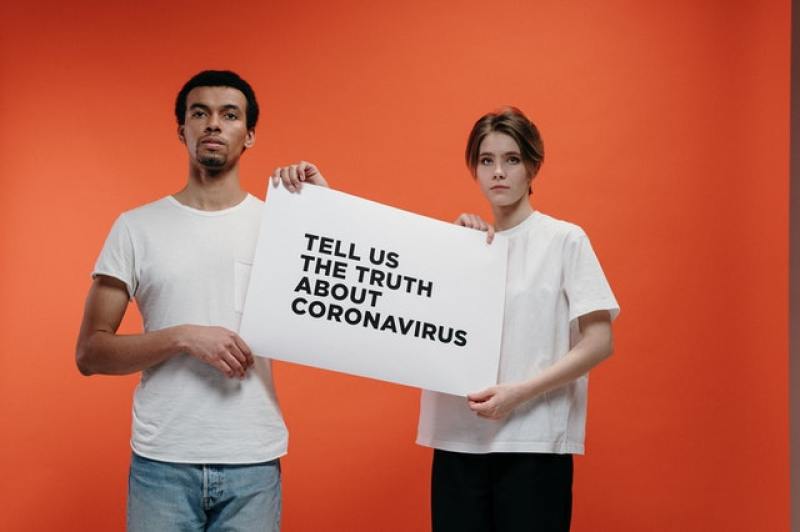
While the world grapples with the issues surrounding the COVID pandemic, important details about the virus and its effects, as well as how governments responded to the global outbreak seem to be either blurry or intentionally hidden from the public. It's about time people know about them.
U.K. newspaper Off-Guardian has compiled all of the key facts about COVID that have been reported by independent news sources over the last few months.
While major media sources remain silent on these issues, Big Tech has been designated as the henchman to continuously suppress these stories by shadow banning, removing posts, or socially disparaging them by labeling them as "fake news."
Some of the important points are listed here, with references to the original sources.
On COVID deaths
The "COVID" virus has a survival rate of more than 99%. In fact, from the outset of the outbreak, medical professionals from the government have said that the overwhelming majority of the public is not in any risk from COVID.
Most studies looking into COVID's infection-to-fatality ratio (IFR) have shown it to be anywhere between 0.04% and 0.54%. In other words, COVID has a survival rate of at least 99.5%.
In light of these findings, it seems that the number of fatalities attributed to COVID was exaggerated and that the majority of deaths were really caused by non-COVID reasons.
Noting that nations worldwide have defined a "COVID death" as "death by any cause within 28/30/60 days of a positive test," Off-Guardian adds that even healthcare authorities in Italy, Germany, the United Kingdom, the United States , and Northern Ireland have confessed to this protocol.
Do Not Resuscitate Orders (DNRs) have increased dramatically in the past twenty months, according to government watchdogs and organizations. These increases are in addition to deaths from comorbidities and pre-existing conditions.
Disabled people's DNRs increased "unprecedented(ly)," as physicians recommended signing DNR orders for non-terminal patients in letters, while others wrote "blanket DNRs" for whole nursing facilities.
Over one-third of all "suspected" COVID patients, according to a Sheffield University study, had a DNR added to their file within 24 hours after hospital admission.
As a result, any rise in death in 2020-2021 may be attributed to the widespread use of compelled or unlawful DNR orders.
On lockdowns
Only a little amount of data suggests that lockdowns reduce the number of "COVID deaths." Lockdowns, on the other hand, have been shown to be more deadly than the "virus" because of the social, economic, and other harms they do to the population's general health.
Even WHO representative Dr. David Nabarro called lockdowns a "global catastrophe" in October 2020:
"We in the World Health Organization do not advocate lockdowns as the primary means of control of the virus[...] it seems we may have a doubling of world poverty by next year. We may well have at least a doubling of child malnutrition [...] This is a terrible, ghastly global catastrophe."
Suicide rates are rising, as is the number of people who are unemployed, living in poverty, abusing alcohol or drugs. Patients who forego or postpone operations or tests are more likely to die from heart disease, cancer, and other diseases.
Consequently, the modest rise in premature deaths may be attributed to lockdowns.
On PCR Tests
The media refers to the Reverse-Transcriptase Polymerase Chain Reaction (RT-PCR) as the "gold standard" for diagnosing COVID. However, the process's Nobel laureate creator said publicly that he never designed it to be used for clinical diagnosis.
"PCR is just a process that allows you to make a whole lot of something out of something. It doesn't tell you that you are sick, or that the thing that you ended up with was going to hurt you or anything like that," he said.
PCR tests are notoriously unreliable. The "gold standard" COVID RT-PCR tests are known to generate false-positive findings by responding to non-specific DNA material.
One patient may receive two different outcomes on the same day, according to Chinese research.
In 2006, researchers discovered that PCR testing for one virus also detected additional viruses. In 2007, reliance on PCR testing led in a fabricated "Whooping Cough" outbreak. In several U.S. experiments, the negative control sample responded.
Experts from different countries also admitted that the test was inaccurate in February 2020.
"The accuracy of the tests is only 30-50%," Chinese Academy of Medical Sciences President Dr. Wang Cheng said.
According to the Australian government's own website, "There is limited evidence available to assess the accuracy and clinical utility of available COVID-19 tests."
A Portuguese court also declared that PCR testing were "unreliable" and thus should not be utilized in the diagnosis of patients.
Former Tanzanian President John Magufuli sent samples of goat meat, pawpaw, and motor oil to the country's national laboratory for PCR testing, and all of them tested positive for COVID.
False positive PCR results were also acknowledged by the World Health Organization twice. A WHO briefing note on the PCR procedure was released by the organization in December 2020, warning laboratories to be on the lookout for high CT values that may lead to false positive findings.
The WHO then issued another advisory in January 2021, this time advising that "asymptomatic" positive PCR tests must be re-tested due to the possibility of false positives.
"Based on what we know about the CT values, the majority of PCR test results are at best questionable," notes the news site.
On ventilators
No respiratory illness has ever required mechanical ventilation to be used as a therapy, and it never has been. Numerous physicians expressed concern about the use of ventilators to treat the "COVID" virus early in the pandemic's course.
But despite all of this advice from several experts, WHO, CDC, ECDC, and the NHS all "recommended" that COVID patients be "ventilated."
In the event of influenza, pneumonia, COPD, or any other illness that limits breathing or damages the lungs, placing the patient on a ventilator will do nothing to relieve their symptoms. It will almost likely worsen the situation and kill a large number of people.
This was not a medical strategy intended to treat patients, but rather to prevent patients from exhaling aerosol particles, which might spread COVID.
According to the experts, patients on mechanical ventilation have a mortality rate of 40 to 50%. More than six-fifths of all "COVID patients" who were placed on ventilators throughout the world died.
The "undercover nurse" claimed that ventilators in New York were being misused to the point that patients' lungs were being destroyed.
"This policy was negligence at best, and potentially deliberate murder at worst," notes the Off-Guardian.
On Masks
At least a dozen studies have demonstrated that masks do not prohibit viral transmission.
The CDC concluded in a May 2020 meta-analysis that face masks had "no significant reduction in influenza transmission with the use of face masks."
Exclusively N95 masks and only in hospitals were studied by the WHO's meta-analysis in the Lancet.
For example, while both North Dakota and South Dakota had a mask requirement, their case numbers were almost similar.
Long-term use of fabric masks, repeated use of the same mask, and other factors may be harmful to one's health. The International Journal of Environmental Research and Public Health has released a lengthy report on the consequences of mask use.
Plastic microfibers found in certain masks have also been linked to lung damage and cancer when breathed.
Children who wear masks are more likely to breathe through their mouths, which may result in facial abnormalities.
Inhaling CO2 has caused unconsciousness in several people, and some children in China have even gone into cardiac arrest.
On Vaccines
No effective human coronavirus vaccine had been created before 2020. Since then, 20 have been produced in 18 months.
Years of research have failed to produce a SARS or MERS vaccine. Some unsuccessful SARS vaccinations produced SARS hypersensitivity. Vaccinated mice may develop the illness more aggressively than uninfected mice. Another effort harmed ferrets' livers.
This is a very different approach from conventional vaccinations, which operate by introducing a weakened strain of the pathogenic bacterium into the body.
When injected into the body, mRNA (messenger ribonucleic acid) vaccines operate by encouraging the body to recognize and produce antigens for viral "spike proteins" by replicating within the cells. mRNA vaccines have been studied since the 1990s, but none have been authorized for use until 2020.
The COVID vaccines were all produced and licensed in under a year. A chemical that is less than a year old cannot have "long-term safety data."
Pfizer admits this in a leaked supply deal with the Albanian government.
Also, none of the vaccines have been properly tested. However, many of them either missed early-stage studies or abandoned them due to "severe adverse effects."
Vaccine makers are legally protected if they cause injury. This is due to the USA's Public Readiness and Emergency Preparedness Act (PREP).
The EU's product licensing legislation does the same, and contracts with vaccine manufacturers reportedly include secret liability provisions.
With regard to COVID-19 or "suspected COVID19" (sic), the U.K. went even farther, providing lifelong legal protection to the government and its personnel.
On Vaccine passports/health passes
Proposed COVID countermeasures have been around since before the virus even appeared as a result of a hasty response in the face of an emergency.
The feasibility of an EU-wide vaccination monitoring system was addressed in two EU papers released in 2018: the "2018 State of Vaccine Confidence" and a technical study titled "Designing and implementing an immunisation information system."
"Vaccination Roadmap" was created from all of these papers, and one of the key elements was the establishment of an annual "feasibility study" on vaccination passports that would run from 2019 to 2021.
EVENT 201 took place in October 2019 at the World Economic Forum and the Johns Hopkins University. This was a simulation of a global pandemic caused by a zoonotic coronavirus. Funding for the experiment came from two different sources: the Gates Foundation and GAVI.
"Call to action" results and suggestions were released in November 2019 as a result of the exercise. After a month, the first incidence of "COVID" was reported by China, where the virus is believed to have come from.
























